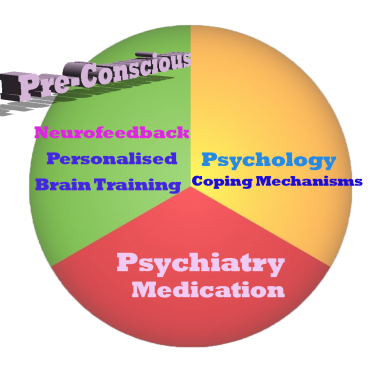Neurofeedback training can be highly effective with various types of incapacitating afflictions grouped here under special needs. The main principle is initially arousal regulation – calming – both physically and emotionally. This generally occurs quickly, within the first session(s). Emotional relating and regulation follows imminently as a result of no longer being in a state of over-arousal or emergency, stress. We can then address specific deficiencies, such as language, motor skills, seizure vulnerability, memory and attention issues.
Neurofeedback training has also been shown to aid in neuro-regeneration.
- Age-related issues
- Dementia
- Alzheimer’s
- Parkinson’s
- Huntington’s
- Multiple Sclerosis (MS)
- Stroke
- Memory loss
- Autism Spectrum Disorder (ASD), Asperger’s
- Williams Syndrome
- ADD / ADHD
- Dyslexia
- Seizures / Epilepsy
Neurofeedback training has been shown to improve cognitive flexibility, creativity, athletic control and inner awareness. It allows the person to detach themselves from the issue that is making their interactions difficult, whether that’s ADHD, dyslexia, learning disabilities, autism or age-related weaknesses, and restores a sense of self-worth and cheerfulness that re-instill hope and positivity. Equipped with this fresh sense of ‘me’, steps to work around issues can be formulated rationally and with empathy. It opens up a realm of emotions and the ability to constructively interact with others.
Neurofeedback is a form of complementary therapy and should not be seen as a replacement for conventional medicine. qEEG brain map-based neurofeedback training takes a more holistic approach to brain functioning, rather than just focusing on medical symptoms. It is not intended as a form of diagnosis nor medical intervention nor medical advice per the disclaimer.
Brain Maps and Personalised Brain Training Explained
Personalised Brain Training with Neurofeedback
Neurofeedback lets us train dysrythmic brain areas. With sensors comfortably fitted to the brain areas we want to train, we detect brainwave patterns real-time while watching a movie. When these patterns are inefficient, the volume drops momentarily. This is the feedback we are giving our brain, short and instantaneously.
The brain area we are training recognises this – while our conscious mind is focussed on the movie – and adjusts its behaviour to restore the normal volume. With repetition, throughout a session, learning occurs.
Meanwhile our conscious mind is solely focussed on the movie; the training process is passive in this sense.
The drop in volume is subtle, so we continue to understand the flow of the movie. No current or electrical stimulation is fed to the brain; sensors simply read brainwaves and the feedback is purely audio-visual.

Neurofeedback trains our Pre-Conscious Mind
Rather than engaging the conscious mind, which slows us down, we are training preconscious processes.
This equips us with the ability to live in the moment and attain our potential (if we have to resort to conscious control, we are not living in the moment).
We take a holistic approach to healthy brain self-regulation, rather than categorisation or diagnosis.
Personalised Brain Training is an advanced qEEG brain map-based approach to neurofeedback training developed by the founders of the field. Taking Othmer Method / ILF training methods further, it employs Default Network Training protocols as developed by David Kaiser.

Neurofeedback is Evidence-based
Neurofeedback training is an evidence-based complementary therapy. Its efficacy was first demonstrated some 50 years ago, and with advances in technology, training protocols have become more efficient and the feedback method – watching movies – thoroughly enjoyable.
Neurofeedback is evidence-based. It’s first application was discovered in 1971 when it was used to resolve intractable epilepsy.
There are over 2,000 peer-reviewed research reports on PubMed demonstrating efficacy across a number of pathologies.
In the US, it is an accepted complementary treatment for many challenges.